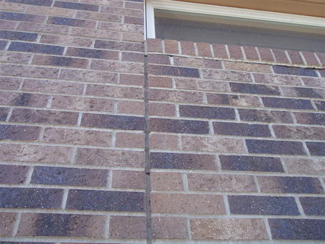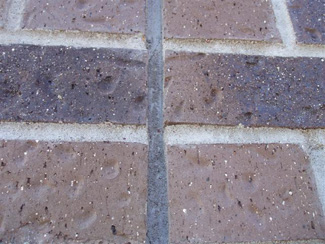Call Today
214 226-6007

Brick Repair
Mortar Cracks
Arch Entry Repair
Chimney Repair
Water Leaking thru Bricks
Masonry Cleaning
Sealing
Expansion Seams
Free Estimate
History/Researh
Links
Many masonry buildings suffer distress. Proper design and detailing, in most cases, could have reduced the distress to acceptable levels or eliminated it completely. One common cause of distress is stress cracking of masonry elements caused by the absence or improper spacing of movement joints. The 2 major types of movement joints are Expansion, and Control joints. The proper use of expansion joints or control joints is not well understood.
INTRODUCTION
Brick is the smallest dimension it will be in its long service life when it leaves the kiln. As it is exposed to moisture from a variety of sources including the air, wet mortar, rain and condensation, it will naturally expand since it is a clay product. Temperature will also cause brick to expand and contract. Consequently, it is important to incorporate expansion joints into brickwork to accommodate this movement. This expansion is very minute. In a long wall this however can add up. In addition, other wall structures cantacting the masonry wall may expand a contract, adding to the need for an expansion joint.


Expansion Joints
Expansion joints may be horizontal or vertical. The joints are formed of highly elastic materials placed in a continuous, unobstructed opening through the brick wythe. This allows the joints to close as a result of an increase in size of the brickwork. Expansion joints must be located so that the structural integrity of the brick masonry is not compromised.
Although the primary purpose of expansion joints is to accommodate movement, the joint must also resist water penetration and air infiltration.
Control Joints
A large slab of concrete on the ground in the form of a road or a parking area is going to move up and down gradually over time. That is to say it's going to crack. You want to have these cracks happen in a place of your choosing.
This control joint is used in concrete or concrete masonry to create a plane of weakness which, used in conjunction with reinforcement or joint reinforcement, controls the location of cracks due to volume changes resulting from shrinkage and creep. A control joint is usually a vertical opening through the concrete masonry wythe and may be formed of inelastic materials. A control joint will open rather than close. Control joints must be located so that the structural integrity of the concrete masonry is not affected.
These two topics of movement in structures are not known or understood by a vast majority of people in the world and result in many repeated repairs and billions of dollars in structural failure.
Roger Landry
Master Masonry Restoration
Dallas Texas
For further study on this topic please visit the Brick Institute of America Tech Notes.

Call Today
214 226-6007
e-mail roger@mastermasonry.com
Site Map
e-mail roger@mastermasonry.com
About Us
Master Masonry has a deep concern for your complete satisfaction of our repairs.
As a second-generation mason, Roger Landry has been performing brick and stone masonry since 1970 when he began as an apprentice to his father.
In addition to being a Master Mason, Roger is a decorated Air Force veteran with a 22 year active duty career.
When it comes to trust, dependability and a very high degree of character, you can count on us to stand behind our work and our word.








